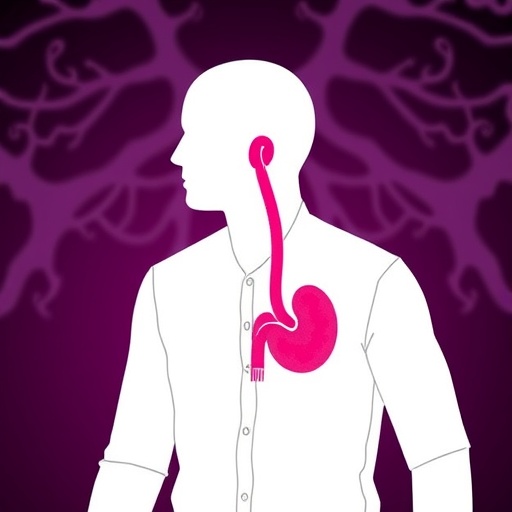Pancreatic ductal adenocarcinoma (PDAC) remains one of the most formidable challenges in oncology, characterized by late diagnosis and dismal survival rates. Despite advances in cancer diagnostics and therapeutics, the elusive nature of early-stage detection continues to hamper clinical outcomes. Recent research has spotlighted Growth Differentiation Factor 15 (GDF15) as a novel biomarker with significant promise for refining prognostic accuracy and potentially guiding therapeutic interventions in PDAC. This breakthrough was highlighted in a comprehensive retrospective study published in BMC Cancer, revealing GDF15’s crucial role in pancreatic tumor biology and survival prediction.
The crux of this investigation revolved around the practical application of GDF15 immunohistochemical expression profiling in pancreatic tissue samples derived from a well-characterized clinical cohort. Researchers meticulously stratified GDF15 expression levels against patient survival data, employing a prognosis-oriented threshold to enhance discrimination efficacy. This methodological rigor allowed for robust correlations between biomarker expression and clinical outcomes, overcoming common pitfalls seen in biomarker candidacy validation.
At a molecular level, GDF15 belongs to the transforming growth factor-beta superfamily and has been implicated in diverse pathophysiological contexts, including inflammation, metabolism, and notably, cancer. Elevated GDF15 expression in PDAC tissue implicates it as a contributor to oncogenic processes such as cell proliferation, apoptosis evasion, and metastasis. The study’s findings confirm that GDF15 is not merely a bystander but actively involved in the progression of pancreatic malignancies, thereby substantiating its prognostic relevance.
Immunohistochemical analyses revealed a stark contrast in GDF15 protein abundance when comparing PDAC tissues to adjacent normal pancreatic parenchyma. This overexpression portends a more aggressive tumor phenotype, aligning with clinical observations of poorer survival. Through Kaplan–Meier survival curves, patients with high GDF15 levels consistently exhibited significantly reduced overall survival, cementing its role as a negative prognostic biomarker.
The clinical implications of these results are profound. Incorporating GDF15 measurement into routine pathological assessments could augment existing diagnostic workflows, such as those reliant on CA19-9 levels, which are often insufficiently sensitive or specific. By providing an additional molecular layer of information, clinicians could better stratify patients and personalize treatment plans, potentially improving outcomes in this notoriously lethal cancer.
Furthermore, the retrospective design of the study leveraged a substantial dataset, enabling statistically powerful evaluations while also acknowledging limitations inherent in such an approach. Notwithstanding, the consistency of GDF15’s association with survival across diverse patient subsets enhances confidence in these conclusions and paves the way for prospective validation studies.
Mechanistically, GDF15’s role within the tumor microenvironment warrants deeper exploration. Its interaction with immune cells, stromal elements, and signaling pathways may reveal therapeutic vulnerabilities. For instance, modulating GDF15 activity could suppress oncogenic signaling or reverse immune evasion mechanisms, suggesting a dual utility as both a biomarker and a therapeutic target.
This novel insight into GDF15 also resonates with broader oncological research trends, emphasizing the utility of multi-omic biomarkers that capture tumor heterogeneity and dynamics more effectively than traditional tools. The study exemplifies the shift towards precision oncology where molecular signatures inform prognostication and dynamic monitoring.
Importantly, the research emphasizes that GDF15’s overexpression is not just a diagnostic hallmark but carries prognostic weight, stratifying patients by survival probabilities with statistically significant precision. This dual capacity enhances its translational appeal and underscores the necessity for integrating molecular pathology into clinical algorithms for PDAC.
The study also highlights the interplay between tumor biology and systemic disease manifestations. Elevated GDF15 levels could reflect not only tumor aggressiveness but also systemic responses such as cachexia, a common symptom in advanced PDAC that severely compromises patient quality of life and survival.
In summary, this investigation offers compelling evidence for GDF15 as a valuable biomarker in pancreatic ductal adenocarcinoma, with ramifications extending from pathophysiological understanding to clinical management. It invites further research into standardizing GDF15 assessment protocols and exploring potential interventions targeting its signaling axis.
As the medical community continues to grapple with PDAC’s lethality, integrating GDF15 into biomarker panels could signify a turning point. Its dual role in tumor progression and prognosis represents a significant stride in the ongoing quest for effective early detection markers and personalized therapeutic strategies in pancreatic cancer.
The robust association of GDF15 expression with adverse clinical parameters marks it as a prime candidate for inclusion in future clinical trials assessing novel anti-cancer agents in PDAC. Its prognostic value could serve as a stratification criterion, ensuring that therapeutic efficacy is evaluated within biologically relevant patient subgroups.
Ultimately, the findings underscore the critical need for multidisciplinary translational research bridging molecular oncology with clinical practice to improve the grim outlook for pancreatic cancer patients. GDF15 stands out as a beacon for this integrative approach, heralding a new era of biomarker-driven precision medicine.
Subject of Research: Prognostic biomarker identification in pancreatic ductal adenocarcinoma with a focus on Growth Differentiation Factor 15 (GDF15).
Article Title: Unveiling GDF15 as a promising biomarker for predicting survival in pancreatic ductal carcinoma: a retrospective research.
Article References:
Xiao, J., Lu, X., Luo, W. et al. Unveiling GDF15 as a promising biomarker for predicting survival in pancreatic ductal carcinoma: a retrospective research. BMC Cancer 25, 1569 (2025). https://doi.org/10.1186/s12885-025-14963-7
Image Credits: Scienmag.com




